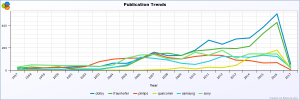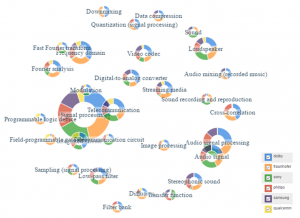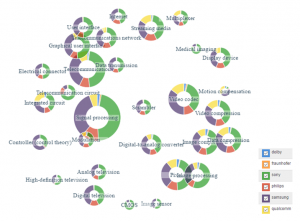
Enterprise IP teams and analysts constantly get asked questions from business groups and management, regarding the position of the company’s portfolio with respect to specific technologies. Often the task is to compare the company’s position with its competitors. Business imperatives constantly shift, changing the context for the above questions. These necessitate analyzing different sections of the portfolio and generating analytics based on different views.
Relecura’s IP Knowledge and Portfolio Management module has been developed to address the above scenario. The solution is flexible and assisted by machine intelligence. It provides different views and analytics of your portfolio and facilitates quick comparison of the relevant technologies and sub-technologies, with those of your competitors.
Dolby Labs – an interesting portfolio
Dolby Labs is a storied company [company profile]. Most of us associate it with consumer electronics and entertainment, specifically with its noise reduction and surround sound technologies. Dolby Labs was founded in 1965 by Ray Dolby in the United Kingdom. The company later moved to the U.S. in 1967 and is now headquartered in San Francisco.
Dolby’s initial success was a noise reduction system for use in recording studios and for film sound. The company made the transition to digital and has adapted well to changing dynamics of the entertainment industry. Over the years it has morphed from being just an audio company to an audio and imaging company. Dolby’s audio and video technology are now present in a complete range of platforms – from movie projection systems, TVs, computers, set-top boxes, gaming consoles, smartphones, and tablets.
Dolby’s latest 10-K filing throws light on how its revenues break out. Of Dolby’s approximately US$1 billion annual revenue, 89% accrues from licensing, 9% from product sales, and the remainder 2% from services. Dolby’s key patents related to Dolby Digital audio technology are expiring this year. It is expected that Dolby’s patent assets related to imaging will maintain and drive its licensing revenues in future.
Portfolio taxonomy
We ran Dolby’s portfolio (restricted to the last 20 years) through Relecura’s Portfolio Management module. We have used the Taxonomy Builder‘s Auto Taxonomy mode to partition the portfolio (in this case, initially specifying a maximum of three levels with three nodes each). We then mapped Dolby’s portfolio to the taxonomy in the Portfolio Manager. The results are shown in Fig. 1 with the number of patent equivalents given for each node. The first-level categories include Multi-channel Sound Reproduction and Speech Synthesis. We also see a reasonable set of patent equivalents in the category of Pictorial Communication. These include Dolby’s patents addressing technologies for video, including movies and TV, on different platforms. The presence of patents in both audio and video supports the assertion that Dolby today is more than just an audio company.
Stereophonic Systems (Multi-channel sound reproduction)

Fig. 2. Dolby vs. Competitors – Patent publishing trends in Stereophonic Systems. (Click for a larger image.)
From the patent publishing trends (Fig. 2) it is clear that Dolby has been actively working in the area of stereophonic systems for a long time. In most years, it has had more patents published in this area than the other key players with larger overall portfolios (like Philips, Samsung, Sony, and Qualcomm).

Fig. 3. Dolby vs. Competitors – Topic Map – Concepts in Stereophonic Systems. (Click for a larger image.)
Fraunhofer Institute is its closest rival in this technology area, with a publishing trend that more or less mirrors that of Dolby.

Fig. 4. Dolby vs. Competitors – Topic Map – Sub-technologies in Stereophonic Systems. (Click for a larger image.)
The Topic Maps (Fig. 3, Fig. 4) show that Dolby has a significant position in terms of total patent assets owned in stereophonic systems, based on the concepts and sub-technologies related to the area.
Pictorial Communication (Imaging for TV/movies)
The situation is reversed in the case of Pictorial Communication, i.e. technologies around imaging and video applicable to a range of applications and platforms for TV and movies.

Fig. 5. Dolby vs. Competitors – Patent publishing trends in Pictorial Communication. (Click for a larger image.)
In this area, it is the larger incumbents like Samsung and Sony that have a greater number of patents published in most years (Fig. 5). Dolby was a late entrant in this area and has not published as actively. It thus has a modest number of patent assets in this area. This finding is reinforced by the Topic Map (Fig. 6) where the number of patent assets owned by the larger players in the various concepts connected with pictorial communication, is much more than those of Dolby.

Fig. 6. Dolby vs. Competitors – Topic Map – Concepts in Pictorial Communication. (Click for a larger image.)
Dolby has been able to offset its smaller patent position in imaging with smart deal-making in video and playing to its audio strengths. It is bringing its surround sound audio technologies to video for smartphones and tablets and targeting the gaming and streaming markets. Its Dolby Atmos system delivers an object-based surround sound experience for movies, TV and smartphones. This is an improvement over the earlier channel based system. This allows the sound to appear to emanate from a particular position on the screen, which can be specified.
Speech Synthesis – Emerging players and rankings (last 5 years)
We compare the top players in the area of Speech Synthesis for the last five years (Fig. 8) with those over a twenty year period (Fig. 7). We notice that Huawei is a new entrant into the Top 10 in Speech Synthesis.
For a more granular view of the relative rankings based on the technologies held by each of the top companies, see Table 1.
Summing up
The Taxonomy Builder offers multiple ways to build and improve portfolio taxonomies. The Auto Taxonomy mode uses AI and machine learning to automatically partition the portfolio with minimal user input.

Table 1. Speech synthesis – Technology-wise company ranking in the last five years. (Click for a larger image.)
The machine suggested nodes may be modified manually and accurately specified by using SME inputs. The taxonomy may also be built in steps. For each new node, the system can be prompted to list possible child nodes with initial machine-suggested specifications for each. These node specifications may then be tweaked.
The Portfolio Manager becomes the repository of portfolio taxonomies created over time, becoming a knowledge-base for different technologies. These can be re-used to create new taxonomies, enhance existing ones, and run portfolio analyses – without the need to run fresh searches.
The charts shown above are only some of the analytics that can be generated to study company portfolios. Get in touch with us if you are interested to know more about the IP Knowledge and Portfolio Management module. We will be happy to schedule a demo.












